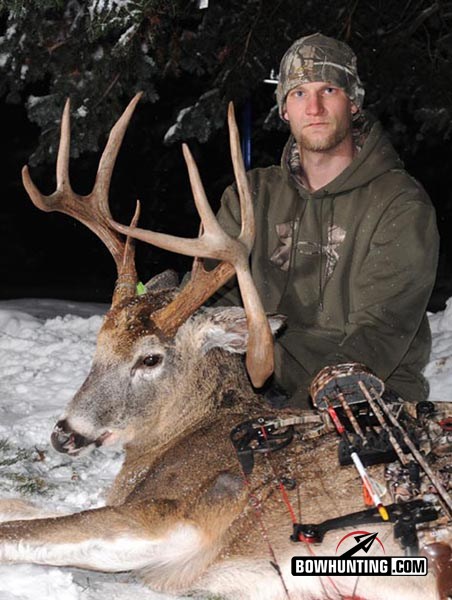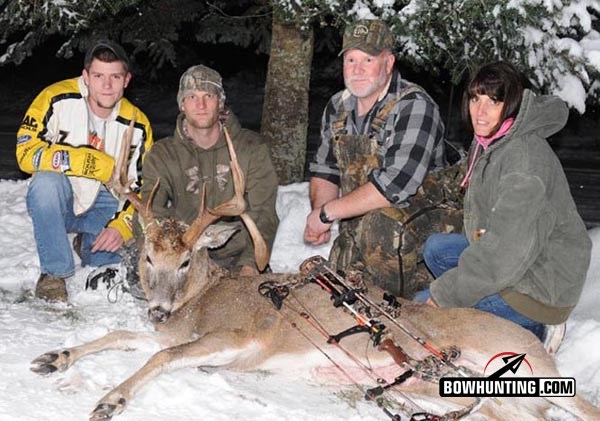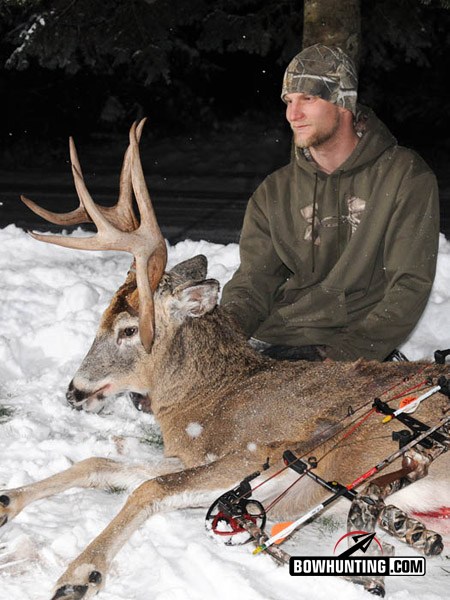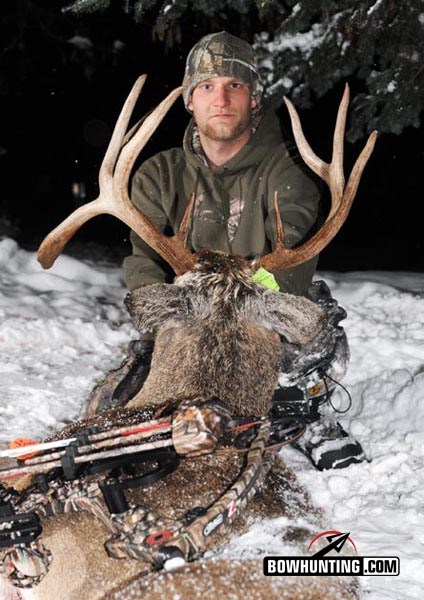LAST UPDATED: May 8th, 2015
Paul Conley had every right to give himself high-fives and back slaps in early December after arrowing the trophy buck he hunted four years in Wisconsin’s Chequamegon National Forest.
Instead, the 23-year-old Mellen, Wisconsin, bowhunter credited his girlfriend, Casey; children, Trinity and Xander; parents, Al and Theresa; as well as grandparents, siblings, buddies and his late friend, Tom Bruckner, for their help in his success Dec. 4.
Paul Conley, 23, shows the big drop-tine buck he shot Dec. 4 in the Chequamegon National Forest near his home in Mellen, Wisconsin.
It was Casey who chased him out the door for late-season hunts when he was burning out, Trinity who asked to see pictures of “Drop Time” when he returned, his grandparents who bought him his first compound bow, and Bruckner who assured him he’d eventually get the buck.
Yep, as Conley recited names, influences and vital roles, you’d have thought he was accepting an Academy Award or the Super Bowl trophy.
Then again, if you ask deer hunters, most would take Conley’s buck over an Oscar or a Lombardi. Why? Beneath the left antler beam on this monstrous 8-point buck hangs a rare 10.5-inch drop tine, which measures 6.5 inches around its end. Further, both main beams measure 21-1/8 inches in length and 7.5 inches around their bases. The tallest tines stand nearly 12 inches above the beams.
Brandon, Paul, Al and Theresa Conley pose with Paul’s monster buck at their home near Cayuga, Wisconsin.
Conley passed up shots at six different bucks the past four years after spotting this buck in his trail-camera photos in 2008. Since then, his cameras recorded the drop-tine buck in hundreds of photos and videos, documenting its growth, antler changes, and daily and seasonal travels.
For instance, the buck’s body appeared largest in 2008, and its antlers reached their peak growth in 2010. The buck’s distinctive drop tine appeared as an antler blemish in 2008 before sprouting into a long tine in 2009. It grew longer and more vertically in 2010, and blossomed into a replica of an old-time police Paddy-whacker this year.
Based on photos and the fact the buck wore its front bottom teeth to the gum, Conley estimates it was 8.5 years old. The buck never appeared at Conley’s bait sites until Halloween each fall, and then visited frequently until late January, when it migrated to winter deeryards farther south. The buck’s feeding visits, however, seldom occurred in daylight.
When Conley reviewed his trail-cam photos from Wisconsin’s nine-day firearms seasons from 2008-2011, none showed the buck during daylight. Until this month, its daylight visits occurred only during the rut from late October through mid-November.
When Conley shot the buck at 7:10 a.m. on Dec. 4, it marked only the second time the buck appeared in daylight after a gun season. The first time was the day before, according to his trail cameras.
Based on trail-cam photos the past four years, and the fact the buck had worn its front bottom teeth down to the gum, Conley estimates the buck was 8.5 years old.
The buck wasn’t eating bait, however, when Conley shot. It was about 300 yards away, returning to its bedding area.
“I had just moved my tree stand to that spot 15 hours before,” Conley said. “I thought I’d try cutting him off between his bed and the bait. I thought he might be going from his bedding area to the bait at dawn. I was expecting him from the west, but he came from the east. It looks like he ran all night and hit the bait before bedding down for the day.”
Conley said his long hunt and analysis of trail-cam photos also revealed interesting details about the buck’s rut-season movements. “Two days after the full moon (in late October to early November), he was out cruising during daylight all four years,” Conley said. “That’s when bucks really started chasing does.”
Conley couldn’t estimate how many hours he spent on stand since 2008, but he was there every day – usually dawn to dusk – starting in late October and running through gun season. He saw the buck six times while hunting; once in 2008, never in 2009, twice in 2010 and three times this year.
He missed killing the buck in 2010 when his arrow cut off a branch between him and the buck. That happened the Saturday before gun season, and it was the first deer he saw during a weeklong vigil.
This year he saw the buck the Monday and Tuesday before gun season, but it wasn’t close enough to shoot. His trail-cam photos also documented three other daytime visits in November while Conley was working.
The buck’s drop tine reached 10.5 inches this year, its largest size since first growing in 2009.
The day he arrowed the buck, he chose his bow instead of a muzzleloader. “I really wanted to get him with a bow,” he said. “That was one of my main goals from the start.”
Soon after he made the 15-yard shot and watched the buck fall five yards away, he called two friends with his news. The word spread so fast his cell phone buzzed the rest of the day.
“Everyone in town knew I was hunting a big drop-tine buck,” Conley said. “I kept it hush-hush the first two years, but I couldn’t keep it in after that. I had friends from here to Green Bay calling to see if I had gotten him.”
What will he do for an encore? Although the Cayuga area holds some of Wisconsin’s lowest deer populations, and most hunters go days, weeks or years without seeing a whitetail, Conley thinks big bucks are worth the wait.
“It wasn’t easy, but shooting this one fulfilled a dream,” he said. “There’s other big bucks out there, and some of them have his antler traits.”

 By
By 







